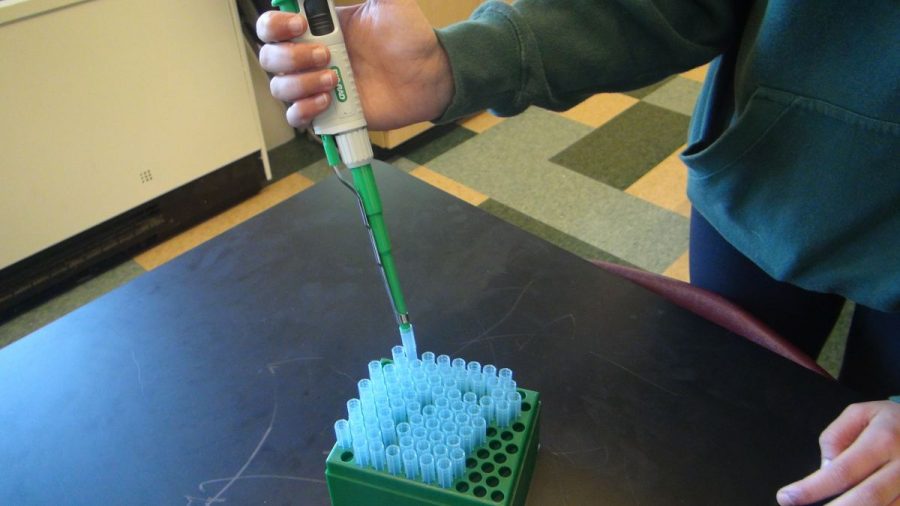Three high school students assisted researchers at Johns Hopkins University in a scientific breakthrough this March.
They successfully redesigned a fully functional chromosome in brewer’s yeast, a first time accomplishment in a complex organism with a cell nucleus.
In a recent Bark interview, Dr. Jef Boeke, the head of the research team, said that this chromosome is the first of 16 total that he and his team hope to genetically manipulate.
Three students conducted research for this study through a program called Build a Genome at Johns Hopkins University, Boeke said. “The program is offered every semester as an undergraduate course and we’ve had three high school students from local high schools participate in a class. They have all successfully made DNA that has contributed to the 16 chromosomes we are currently working on.”
Abena Apaw, now at Washington University, was one of the three high school students interning in Dr. Boeke’s lab who helped build a part of the genome for the first engineered chromosome. “For two summers between the 10th and 12th grades, I had the honor of being an intern at the Boeke laboratory at the Johns Hopkins University Medical School at Baltimore as a participant of the Center for Excellence in Genome Studies Scholars program at the Johns Hopkins University, a program run by the National Institute of Health (NIH). At the lab, I learned to conduct scientific research in the real world,” said Apaw in an email interview. “I also completed an undergraduate course, Build-A-Genome, with Dr. Jef Boeke at the Johns Hopkins University during the fall of 2010 semester. I worked at the lab during the school year as well. This includes going to the lab after classes 3 days a week and sometimes over the weekends.”
Jack Mountain, senior, is a high school student who worked on a smaller project within Boeke’s study for all of his junior year and the first semester of his senior year. “[Boeke’s] project aimed to synthesize the chromosomes in the nucleus of the yeast, [while] my project focused on the much smaller secondary set of DNA located in the cells’ mitochondria. The design plan and experimentation of my project was similar to that of [Boeke’s] project,” Mountain said in an email interview. Mountain added that he had a greater role in the procedural steps and design plans than he expected.
This study, conducted with the help of high school and undergraduate students, signals the beginning of an entirely new era of genetic manipulation which could lead to more efficient biofuels and other essential medicines.
Boeke and his team took a strain of DNA letters on a computer with special software and made precise designed alterations to the sequence while following a careful set of rules. After following a series of complex steps, his team designed a chromosome that changed 273,000 DNA letters out of the over 316,000 in yeast, Boeke said.
Although similar genetic manipulation had been conducted previously with bacteria, this is the first time that a eukaryotic organism, an organism whose cells have a nucleus, was genetically manipulated. This is perhaps the first step towards manipulating the DNA of higher life forms. All mammals, including humans, are eukaryotic.
“It was certainly a very extensively engineered piece of DNA,” Boeke said.
The resulting designer yeast, however, was remarkably indistinguishable from natural brewer’s yeast, Boeke concluded.
“One of the big surprises was when we finished, the yeast looked, smelled and behaved a lot like yeast. It was almost like you couldn’t tell the difference,” Boeke said.
The technique for rearranging DNA sequences artificially, Boeke’s “genome scrambling system,” used cutting edge technology involving a virus which inhabits a particular bacteria called Cre recombinase.
“We could introduce a very specialized, controllable version of Cre recombinase with a chemical,” Boeke said. “When we add the chemical, it allows us to generate millions of variant chromosomes that have changes. The chromosomes might be missing a gene, have some of the genes in a different order than they were originally, or we could even increase the copy number of genes. And there is nothing quite like this in nature. So we call it a genome scrambling system.”
Scrambling these chromosomes unlocks a huge number of new types of designer yeast, some of which could have profound medical and technological implications.
“You could think of a genome as a deck of 5,000 cards with each card being one gene. With the scrambling system you could take that deck of cards and change the order of the cards by shuffling the deck, pulling cards out of the deck, or even sticking extra cards into the deck,” Boeke said. “Now imagine you have a million decks of 5,000 cards, all of which had been shuffled in a different way. That’s what you would have in 1 milliliter of yeast in the genome scrambled. So in the card analogy, there’s one of those decks that is going to give you the winning hand for biofuels or producing some medicine because yeast is used extensively in biotechnology now.”
To the ordinary observer, it seems as if Boeke is virtually creating new life forms. Boeke, however, characterizes what he and his team are doing not as ‘creating’ life, but only as building on a previous blueprint. Rather than completely making a new chromosome he and his team swapped in new genes for the old genes sections. At each point the experimenters checked to see that the chromosome was still functioning, Boeke said.
Boeke and his team have anticipated and are sensitive to the ethical issues concerning his work. His team created a detailed set of ethical rules in collaboration with the head director of the Federal Bureau of Investigation’s Weapons of Mass Destruction Commission.
The need for strict rules are due to the fact that, among other things, the technologies involved could be utilized to make a destructive virus, Boeke said.
“You always come up with ways that technology can be misused so we try to be responsible scientists. We actually have a bioethicists on the team and we wrote a state of principles. To be honest, yeast is an incredibly safe, harmless creature that we have been engineering for decades on a smaller scale,” Boeke said. “[Yeast] is actually a great thing to carry out an experiment like this in. This is the next step in large scale engineering. We are very aware that there needs to be a human practice component as it is a big part of synthetic biology.”
Boeke’s team, with the help of other student interns and international affiliates, hopes to genetically manipulate all 16 chromosomes in the yeast.
“There are teams in China working on three or four different chromosomes, there are teams in the UK, and soon we will be joining collaborators in Singapore and Australia, so this is really a world-wide project.”


